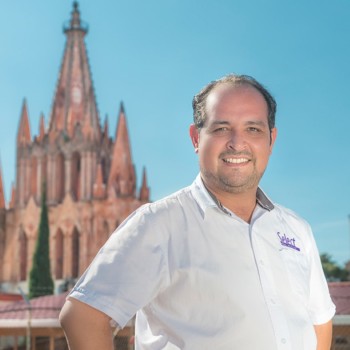d. A bit more history (4)
The cultural aspect of San Miguel de Allende remained vibrant at the beginning of the 20th century, and it was with the arrival of Mr. Felipe Cossio del Pomar that the first art school was established. Later, the Instituto Allende was restored, enhancing the existing artistic atmosphere. The story of Mr. Stirling Dickinson is fascinating, as he made significant contributions throughout his life in San Miguel de Allende. Personally, I had the pleasure of meeting him when the baseball stadium was inaugurated in his name. There is a wealth of biographies and articles about Mr. Stirling Dickinson’s life and work in San Miguel de Allende.
Another notable figure who arrived in San Miguel by chance during that early period was Jose Mojica. His story is both interesting and emotional, not only because of his artistic and religious career but also due to his legacy, which he documented in his autobiography “Yo Pecador” and the film of the same name, shot in 1959. The locations included the town of San Miguel de Allende, where his life and work are narrated. The scenes of San Miguel de Allende are particularly interesting because, although the town has changed significantly in recent decades, one can still appreciate the details that have made San Miguel de Allende timeless.
The cultural life of San Miguel de Allende in those first decades of the last century was enriched daily by the contributions of those who already lived in San Miguel de Allende, the art school students, but especially by those invited to enjoy a picturesque town lost in the mountains. The great comedian Cantinflas also made San Miguel his home, and in the 1964 film “El Padrecito,” he showcased various scenes of San Miguel from those times.
San Miguel was also the birthplace of great figures, such as Don Pedro Vargas, the Continental Tenor, with a significant musical career in radio, television, and film, participating in international productions such as Disney’s “The Littlest Outlaw” (1955), mostly filmed in San Miguel de Allende.
Talking about all the figures who contributed to the life of San Miguel from the 19th century to the first half of the 20th century is quite extensive, as the cultural environment continues to grow in all its facets. The emergence of internationally recognized festivals, art centers, galleries, and public spaces constantly presents works of excellent value. The theater, reading, and painting groups offer a wide variety of expressions. The architecture found in its alleys and streets takes us through the centuries to the present day, creating an atmosphere where we can recall and live past times while enjoying the contemporary daily life. With influences from the pre-Hispanic and Spanish colonial periods, the Independence and Revolution, and the amalgamation of different cultures from around the world, all converge in a town lost in the mountains of Mexico.
d. Otro poco de historia (4)
La parte cultural de San Miguel de Allende se mantenía viva al inicio del siglo XX, y fue con la llegada del Sr Felipe Cossio del Pomar cuando se crea la primera escuela de artes, y posteriormente se restaura el Instituto Allende, acrecentando el ambiente artístico existente. La historia del Sr Stirling Dickinson es muy interesante en lo que realizó a lo largo de toda su vida en San Miguel de Allende, en lo personal tuve el placer de conocerle cuando se inauguró el estadio de béisbol, en su nombre; Sobre el Sr. Stirling Dickinson hay bastante biografía y artículos disponibles acerca de su vida y obra en San Miguel de Allende.
Otro personaje que por azares del destino llegaría a San Miguel en esa temprana época fue Jose Mojica, cuya historia es por más interesante y emotiva, tanto por su trayectoria artística y religiosa como por su legado, plasmado en su autobiografía “Yo Pecador” y la película del mismo nombre filmada en el año 1959, teniendo como parte las locaciones el pueblo de San Miguel de Allende, donde se narra su vida y obra, y las escenas de San Miguel de Allende son muy interesantes porque, si bien ha cambiado mucho en las últimas décadas el pueblo, todavía se pueden apreciar esos detalles que han hecho a San Miguel de Allende atemporal.
La vida cultural de San Miguel de Allende en esas primeras décadas del siglo pasado se veía enriquecida día a día con los aportes de quienes ya vivían en San Miguel de Allende, los estudiantes de las escuelas de arte, pero sobre todo de aquellos invitados a disfrutar de un pintoresco pueblo perdido en las montañas, el gran comediante Cantinflas hizo de San Miguel también su hogar y en la película “El Padrecito” de 1964, muestra varias estampas del San Miguel de aquellos ayeres.
También fue cuna de grandes personajes, como Don Pedro Vargas, el Tenor Continental, con una gran trayectoria musical en la radio televisión y cine, participando en producciones internacionales como “The Littlest Outlaw” (1955) de Disney, filmada mayormente en San Miguel de Allende.
Hablar de todos los personajes que desde el siglo XIX a la primera mitad del siglo XX aportaron algo a la vida Sanmiguelense es bastante extenso, porque aún continúa el crecimiento del entorno cultural en todas sus facetas, nacimiento de grandes festivales de reconocimiento internacional, los centros de arte y galerías, los espacios públicos que constantemente nos presentan obras de excelso valor, los grupos de teatro, de lectura, de pintura que ofrecen una gran variedad de expresiones, la arquitectura que encontramos por sus callejones y caminos nos lleva de la mano a través de los siglos hasta el dia de hoy, haciendo que el ambiente que vivimos, los espacios que compartimos, en los distintos rincones de San Miguel de Allende nos llevan a recordar y vivir tiempos pasados y disfrutar de lo contemporáneo en el dia a dia; con la influencia prehispánica y del virreinato español, de la Independencia y Revolución, de la amalgama de distintas culturas del mundo, tienen como crisol un pueblo perdido en las montañas en México.






